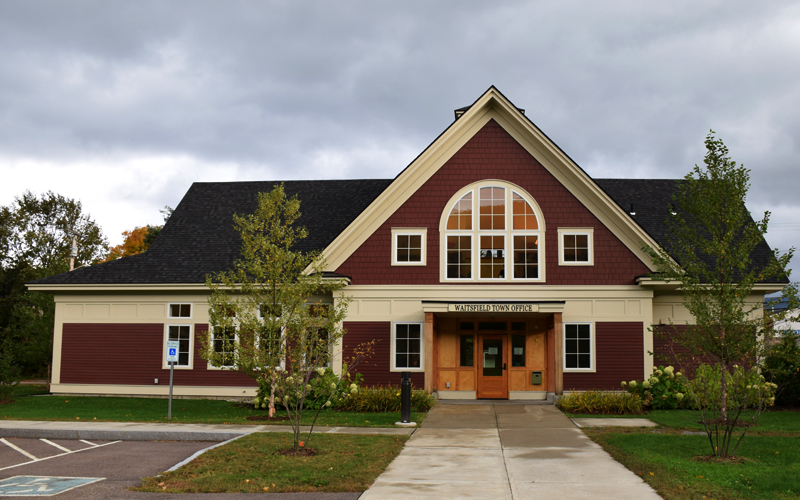The Waitsfield Development Review Board was supportive of a plan to create either a planned residential development of 15 affordable lots or a planned hamlet development of the same size.
The town’s zoning currently allows a planned residential development (PRD) with a 50% density bonus if affordable housing is being developed and if the development is clustered and open land preserved. A planned hamlet development (PHD) offers more generous density bonuses, but the town planning commission is taking PHDs back to the drawing board for another look.
At a September 9 hearing, DRB members heard from Mac and Bobbi Rood who own 10.6 acres of land in Waitsfield just south of Kingsbury Road on the west side of Route 100. The Roods live on a house on that parcel. The Roods, with Warren architect David Sellers wanted to begin a discussion with the DRB about developing that property into 15 affordable lots (including their own).
“In collaboration with Dave, we’d like to create an affordable housing community here. This site plan shows 28 lots that would have worked if the hamlet zoning were passed. We’ve subsequently decided to aim for 15 total, including our own house,” Mac Rood said.
“We’d like to get a sense from the board that we’re aiming in the right direction with a project that would get approval. We haven’t done a septic analysis; we’d love to have a sense from the board that this is a good thing before we spend a ton of money on that,” Rood said, noting that their intention was to donate an easement to the Mad River Path across their property and to lobby their neighbor to the north to do the same to connect to Kingsbury Road.
A portion of the property is in the fluvial erosion hazard overlay district and cannot be developed.
PLACE FOR HOME OWNERSHIP
“Mac and I have both had our careers in The Valley and we know that affordable housing is really hard to do. Our notion is to see this as a place for homeownership, not rentals. Our concept is to make this like a neighborhood. These houses won’t be for rent and we won’t be landlords,” Sellers said.
“We want to seek designers and owners and bankers. We’ve talked to banks that are very supportive. We want to put together a team of designers, builders, owners and bankers. There is a giant demand and we’re going to try and fill some of it. There’s a lot of engineering that needs to be done. We want to make these affordable for people earning $55,000 to $95,000 a year who can get the bank to give them $200,000 to build a small one- to two-bedroom house,” Sellers continued.
Rood said that they were working on the legal language needed to make sure the lots and the subsequent houses remain affordable and said they do not intend to build the structures before the lots are purchased.
DRB member John Donaldson said that the PRD language is old and written in a way that envisions the developer building the house.
“I think you need to demonstrate proof of concept and demonstrate a design that will work with the affordability guidelines,” Donaldson said.
“Mac and I don’t want to design them all. We’re challenging designers in The Valley and the state to show us what they can do within the limitations of size and cost,” Sellers said.
DRB board chair Chris Cook said that the DRB’s responsibility is to look at the guidelines and provide direction and a sense of how to move forward.
“We’re not going to solve how you make perpetually affordable housing units on this (Zoom) call. Now with my DRB hat on, I’d agree that this project is not visible from Route 100 and a great location for development. The driveway onto Route 100 is my only concern. Would it need a traffic study?” Cook asked.
Donaldson noted that septic capacity may limit the size of houses and also the size of lots.
Rood said that his reading of the zoning and the size led him to believe lots could be 0.6 acres or less.
Cook polled board members for their preliminary thoughts on the proposed project, noting her concern was access onto Route 100.
Board member JB Weir concurred on the road issue, but was supportive, as was board member Rudy Polwin who said that that talking to VTrans about site lines could be a good first step.
Board member Duncan Brines raised concerns about how to keep the development affordable in perpetuity.
“This is a great location. I like the clustered development. I share the concerns already mentioned about access and septic capacity,” said board member Gib Geiger.
“I’m encouraging you to continue on from my seat,” Cook said.
The DRB also discussed the planning commission’s plans to revisit its PHD zoning amendments with planning commissioner Alice Peal who was on the call.
DRB member Steve McKenzie said the Rood/Sellers project would be a great project for PHD zoning.
The board voted to consider the proposal a major subdivision.







